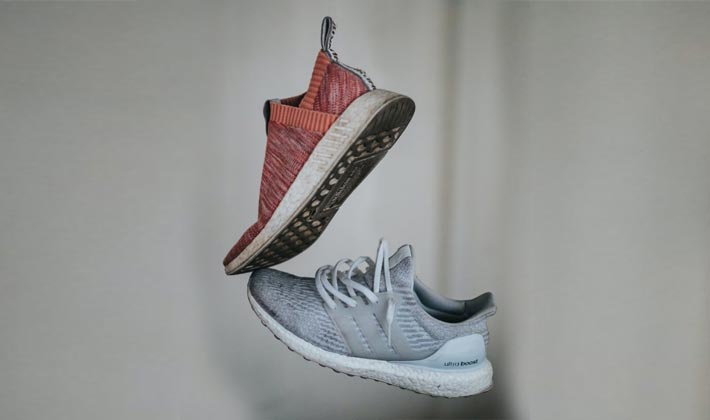While treadmill running and outdoor running have their differences, for the average recreational runner, your outdoor running shoes should work well on the treadmill. However, it may be a good idea to switch shoes for your other workouts in your home gym.
Treadmill & Free Weights Footwear
If you typically run outdoors, it’s advised to keep similar parameters as you get started on your treadmill (such as distance, speed, shoes). At the onset, it’s not recommended to start on an incline if you don’t typically run hills outdoors. As you progress, start to include progressions into your workout routine.
Running shoes typically feature:
- cushioned sole
- firm heel counter (squeeze the back part of the shoe – it will feel firm and unyielding if it offers good support) and
- a stiff shank (twist the front and back of the shoe to ensure it is stiff)
The shoes you wear on the treadmill should have these features too.
In most cases, you can use the same shoe for treadmill use as well as free weight routines. If you have a goal to strengthen lower limb musculature and improve foot function, then perhaps a more flexible shoe will give those muscles a workout; again, this should be done with caution and each individual has their own unique circumstances.
Training Shoes vs. Running Shoes

A training shoe is often quite different than a running shoe. Training shoes are typically more flexible and have less cushioning – they are designed to engage the muscles to a greater extent, giving the feet, ankles, calves and upper legs a more purposeful workout. For at-home fitness equipment like treadmills, steppers, and ellipticals, a running shoe is likely best. At-home activities like circuit training, plyometrics, and agility workouts where you are using your own body weight are best for training shoes. Some examples are squats, lunges, burpees, jumping jacks, bear crawls, ladder work, and box jumps.
Barefoot Workouts
If you have never worked out barefoot before, you should not start without consulting a health care professional such as a Canadian Certified Pedorthist. Doing exercises barefoot can have tremendous benefits, but you need to know where to start. Starting with barefoot exercises too fast, too soon, without proper guidance can result in all kinds of foot, ankle, knee, hip, and/or back problems.
However, contrary to too fast too soon, gradually introducing your body to some barefoot exercises can have considerable positive outcomes for healthy individuals. The first step is understanding your foot’s neutral alignment – your Pedorthist can help you with this – essentially it is the central position where your foot is positioned for optimal function. Once established, start building resilience around this corrected position by simply balancing on one foot for 20 seconds at a time in this aligned position. Gradually progress to 1 minute over the course of a few weeks. Active individuals who are used to dynamic and plyometric exercises can progress in a more dynamic fashion, such as barefoot ladder work, clockwork single leg jumps and bosu ball balancing.
Orthotics
If you typically wear your custom orthotics and shoes regularly, then exercising at home should be no different. Be cautious not to use an orthotic that is designed for something else. i.e. an orthotic designed for long periods of standing at work can have vastly different properties for one that is designed for running. If you are unsure, reach out to your Pedorthist for clarification. Even if their practice is currently closed due to the COVID-19 lockdown, many clinics are assisting patients virtually.
By Darius Dinshaw B.Sc. Kin, C. Ped (C), CAT(C), CSCS
